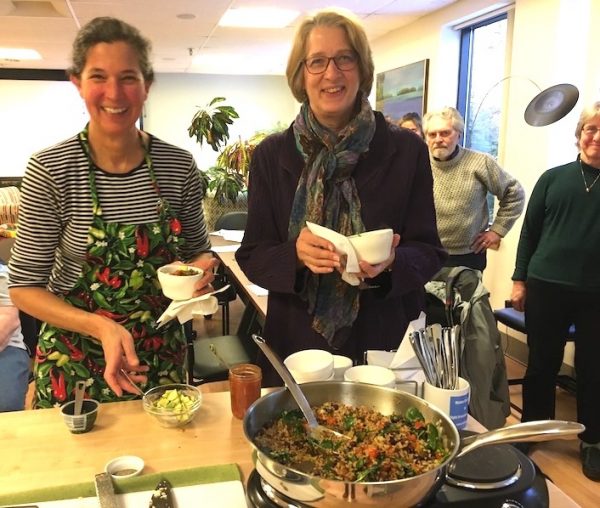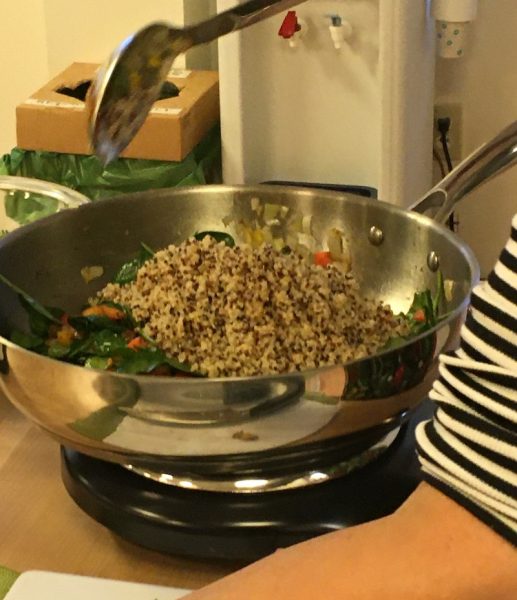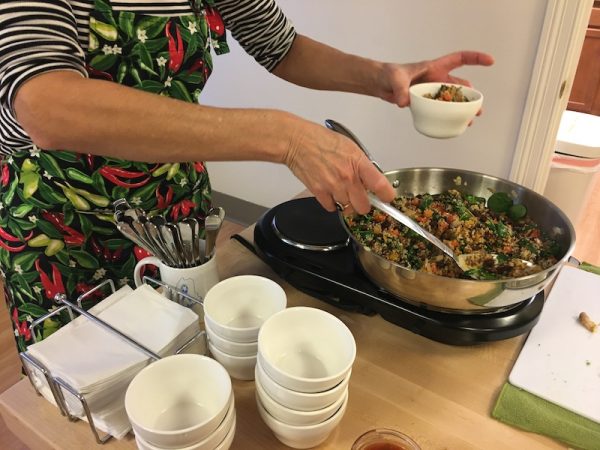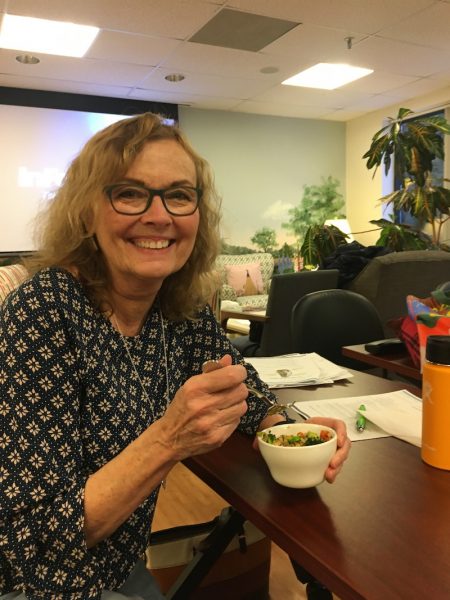This picture represents why I’m enjoying the Food is Medicine class at the Dempsey Center in South Portland so much. Happy, hungry, friendly people! Registered dietitian Judy Donnelly has been teaching us about the health benefits of the food we eat. This class was all about fiber, why it’s necessary, and which foods are rich in this plant-based nutrient. I learned all kinds of important things, which I’ll get to in a minute.
Judy always delivers an information-packed presentation but she also demonstrates a recipe or two, and the real show gets underway when she sharts slicing, dicing, chopping, and cooking her healthy ingredients. It’s kind of mesmerizing and smells so good. All the while, she passes along helpful tips. Such as when you’re sautéeing a bunch of vegetables, stem the urge to throw them all in at once. Carrots take longer so should go in first. Wait a bit for bell peppers. As I mentioned in a previous post, if you’re using garlic, chop it up and set it aside for about 10 minutes before cooking. That’s because when you chop it, an important enzyme is released. If you add heat too soon, you’ll stop the process.
When a recipe is done, we get to eat it! So, we get facts and we get a healthy meal. But apropos of the title, food is medicine for reasons other than nutrients. When you get to share a meal with people, that is also good medicine. I didn’t really know anyone else when I started the class, but I feel as if I’ve made some new friends. We’re learning together — from Judy and from each other.
Judy made us quinoa bowls — two versions. Here’s the recipe:
Quinoa Bowls
Ingredients
- 1 medium onion, diced
- 1 green or red bell pepper, diced
- 1 large carrot, 1/4″ dice
- 1 clove garlic, chopped
- Greens of your choice, generous handful, chopped — chard, spinach, kale, etc.
- 2 TBS olive or sesame oil (olive for Mexican, sesame for Asian)
- 1 cup quinoa, rinsed as need
- 1 3/4 cup water
Protein options:
- 1 15-ounce can black beans
- 1 lb chicken breast, cooked and diced
- 1 lb shrimp, cooked
- 1 brick extra firm tofu, diced and sautéed
Directions
- Prep all veggies.
- In saucepan, heat water to a boil, add quinoa, bring back to a boil, turn down heat, and simmer until water absorbed. (Two to one ratio of water to quinoa.)
- While quinoa is cooking, sauté vegetables, starting with onions and carrots for 4-5 minutes. Add bell pepper, sauté for a few minutes more, then add garlic and spices. (See spice combinations below.)
- Finally, add greens and toss with other veggies until wilted. If food is sticking to the pan you can add a little extra oil or a couple of TBS of water to release everything from the pan.
- Combine with quinoa and a protein of your choice.
Make it Mexican
Combine 1 TBS chili powder, 1 tsp cumin, a pinch of red chili pepper flakes, and salt. Add to vegetables just before adding greens. Top with any combo of the following: diced avocado, shredded cheddar, fresh cilantro, and salsa.
Make it Asian
Combine 2 tsp fresh grated ginger, 1/2 tsp turmeric, 1-2 TBS lite soy sauce, pinch of red pepper flakes, 1 TBS sesame seeds. Add to veggies just before adding the greens. You could also add Asian mushrooms (Shitake mushrooms have anti-inflammatory properties) to this mix at the same time as the peppers.
Tips
- Use extra chicken that has been prepared for a different meal.
- Although onions are softer than carrots, you can cook them at the same time — it will help sweeten them.
- Quinoa has a bitter-tasting coating, so give it a rinse in a mesh sieve before cooking.
- If you’re not sure if quinoa is done, a handy clue is that there’s no more steam coming from under the lid.
- If you use dried beans, soak and cook before adding to the recipe. If you use canned beans, rinse to reduce the amount of added salt.
Why is the recipe good for you?
The quinoa bowls are good for us because, for one thing, they are full of fiber. And the benefits are:
- Decreases risk of diabetes, high blood pressure, cholesterol, cancer, and diseases of the large intestine.
Main sources of fiber
- Whole grains (like quinoa), beans and legumes, fruits, vegetables, nuts, and seeds.
Judy explained the difference between soluble and insoluble fiber, something I didn’t know. I just thought fiber was fiber.
SOLUBLE FIBER attracts water and thickens up when digested, which slows things down. It helps decrease LDL or bad cholesterol, slows down loose bowels, and decreases the risk of diseases of the large intestines.
- Whole grains
- Oats, barley, flaxseed
- Nuts, seeds, beans, lentils, peas
- Applesauce, pears (with skin), prunes, apricots
- Potatoes and other veggies
- Fiber supplements
INSOLUBLE FIBER is almost like a brillo pad that helps food pass more quickly through the digestive tract adds bulk to a stool. It reduces the risk of diverticular disease, constipation, and colon cancer. And it helps keep you regular.
- Whole wheat, bulgur, corn
- Bran, nuts, beans
- Fruits and vegetables
Tips for increasing your fiber intake
- Eat more whole grains (Read labels, especially on bread, cereal, and crackers to see if it really contains whole grains).
- When baking, use half whole grain, half white flour if you don’t want to go 100% whole grain.
- When you cook brown rice or quinoa, make enough for leftovers that can be used in another meal.
- Include whole grains in snacks.
- Add raisins, walnuts, apples, and other fruit to … whatever.
- Experiment
How much fiber?
- Kids — their age plus five. So a two-year-old would get 7 grams a day.
- Adults — 20-35 grams a day of both soluble and insoluble fiber.
Judy also stressed that it’s important to add fiber to your diet gradually and to drink plenty of water. Visit the Dempsey Center website to see what all they offer for classes and support programs.
PS Both versions of the quinoa bowls were very good. My personal preference was the Mexican version because I LOVE avocados. Also, we topped it with salsa that Judy made from tomatoes she grew in her garden, which added another touch of flavor.





Leave A Comment